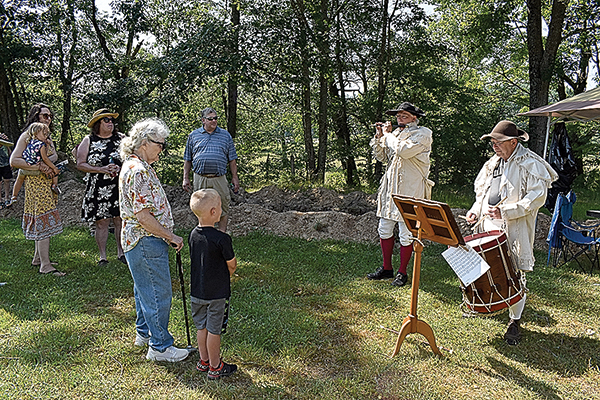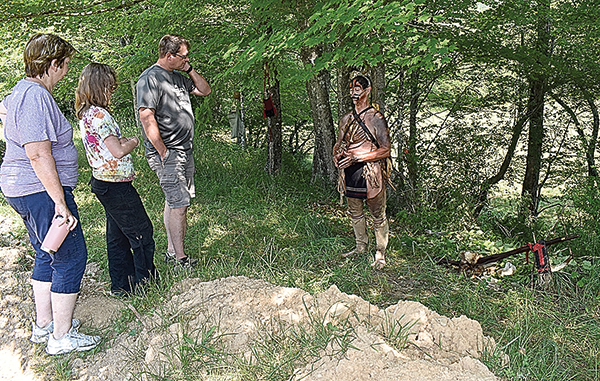
Suzanne Stewart
Staff Writer
Two-hundred fifty years ago, a piece of land in Green Bank was abuzz with activity, when Virginia militiamen were at work building a fort in the summer of 1774.
Last weekend, the area was yet again abuzz with activity as Fort Warwick celebrated its 250th anniversary. Archeologists were leading digs on the site, re-enactors were sharing stories of what life at the fort and in the area was like and artisans were sharing wares that were made and used in the 18th century.
University of Kentucky archaeologists Stephen Mc-Bride and Kim Arbogast McBride, who have been working with Fort Warwick owners Bob and Elaine Sheets since 1989, led groups through the site and gave the history of the digs and artifacts that have been found.
“I’ve had the privilege to work on this site since 1989,” Kim said. “We had a project to try to locate frontier forts in the region and James Wooddell – an older historian – sat with me and pointed down in this direction and said, ‘oral tradition says this was Warwick’s Fort.”’
Kim said she used a metal detector on the area and, sure enough, found something. Metal detectors are usually the best way to find pre-Revolutionary war forts because there are nails and fragments of metal items that were used by the colonists.
“They do not have a high density of artifacts, so our traditional archeological survey methods would actually often miss these sites,” she said. “Typically, we dig little holes in the ground, sift the dirt, but you could easily do that on a fort site and not get anything. The metal detectors help us find the nails and the second most common artifact is the cast iron kettle fragment because those kettles would frequently explode with heating and cooling.”
Since that initial discovery, there have been dozens of digs hosted at the fort, including by students from local schools. Artifacts including pottery, glassware, metal buttons and clothing adornments are just a few examples of what has been found and now on display in the Fort Warwick Museum on the site.
The most recent discovery was that of the stockade, which was found after excavating the areas that were thought to be the walls of the fort.
“These trenches that you see were dug this year, just recently, with a track hoe by Jed Sheets with Stephen McBride, my husband, working with him,” Kim said. “We have found in those trenches strips of stockading. As you dig in the top soil, then get down about eight to twelve inches, that soil changes into a clay layer that’s much older. You can see that clay is a nice light color. Anywhere somebody in the past, or an animal or a tree root, has penetrated into that clay, it leaves a brown stain.
“That is what archeologists follow,” she added. “Especially in the pits that are being excavated.”

In addition to the archeologists, there were several re-enactors at the fort site giving a glimpse into what life there was like 250 years ago. Portraying a militiaman, Andrew Bragg talked about life at the fort and the daily routine the militia had, preparing for possible attacks and making sure the area was safe.
Joining the militiamen were two very important members – the fife and drum corps. Fifeman Paul Vosteen and drummer Grant Huddle performed and explained each tune and its significance to the militia.
“Fife and drum were important because we taught the soldiers what to do,” Vosteen said. “When we did certain calls, we taught them what that call meant. So every single time we do that call, they’re like, ‘oh that’s the call for breakfast.’ We also had to play a tune like ‘Pioneer March.’
“To the pioneer in the 18th century military, that’s a work detail,” he continued. “Those are the guys who are being called to do the dirty jobs. They had to go cut the trees. They had to go haul the firewood. They had to fetch the water.”
Needless to say, “Pioneer March” was not a favorite tune among the militiamen.
The fife and drum also helped the militia keep time. As they marched away from the fort, if they were planning to go 20 miles away, the fife and drum tune would give them an idea of how long it would take to march that distance.


There were other inhabitants in the area during the 18th century. Giving insight into the Native American lifestyle at that time was Shawnee Indian portrayer Doug Wood.
Wood set up a camp near the fort and explained that it was indicative of a camp for warriors who were on a scouting trip.
The camp included a bow bed made with leaves with a forked stick next to the head of the bed. The stick was there so the warrior had his gun loaded and ready in case they were ambushed. Near the bed was a circle drawn in the dirt with two bent sticks in the center.
One stick was pointed to the horizon, showing what time they left home to make camp and the other stick pointed toward where the sun will be in the horizon when they plan to return.
Wood also had a pictograph he made on a tree in his camp. He peeled away the bark and made a drawing telling who was on the scouting trip and how well they fared during their time away from home. The drawing was made with charcoal mixed with bear grease.
“This is a pictograph indicating the success of the party,” he said. “In the upper right corner is going to be a representation of the leader of the party. What is represented here are his tattoos. Anybody who knows this guy knows his tattoos. Out from the right ear is going to be a representation of the person’s elder clan being. When the animals were more powerful than people, the animals had conferences and councils together. The progenitor of my clan is the squirrel.”
As the leader of the party, Wood was depicted with a head that showed his three face tattoos. Above the head was a bobcat paw which depicts his name, Chingwee. Below the head is a drawing of his chest plate and three wampum belts which means he has been to battle three times.
“This is a war belt and basically is a device to recruit other warriors to go to war,” he said.
Beside that in the pictograph is a depiction of four blankets, meaning the party has been away from home for four days. To the far left in the drawing is representation of the warriors in the party. Included in that list is a broken arrow, signifying that one of the warriors was wounded in battle.
At the very bottom is a depiction of how well the party did on its scouting trip. A man with a hat, two headless men, a young girl and a headless woman are drawn in a row. This shows that a man and young girl were taken captive and two men and a woman were killed and scalped.
The scalps were taken home to be given to families who lost loved ones in the past year. The scalps were used as part of the grieving process.
“They would name the scalp after the deceased relative, take the scalp to dances, take the scalp to the feast, everybody who was close to them would call the scalp by that person’s name,” Wood explained. “The elder of the town would say the mourning period is over and then the scalp goes to the person who took it.”
Saturday’s celebration also included demonstrations from artisans who carry on the trades and artistry of the 18th century.

Terry Carr, of Huntersville, had his blacksmith forge on site and was making nails and some more decorative items. Dawn Baldwin Barrett had samples of her herbal teas made with locally sourced flowers and herbs.
Staunton, Virginia, couple Paul and Elissa Parish shared their knowledge of colonial living. Elissa demonstrated tape loom weaving, and Paul shared land surveys he has done with 18th century tools. Paul also had a display of tape looms he has made.
Artist Vivian Blackwood was demonstrating archeological sketching and explained that before there were cameras, archeologists had to rely on their drawing abilities to record what they found during digs. She was accompanied by her fiancé Philippe Willis, who is also an artist. He had a display of animal pelts and taxidermy animals. He shared his knowledge of preserving pelts.
Tim and Terry Duff, of Fair Lawn Farms in Monterey, Virginia, had a display of handmade musketloaders and powder horns. Tim showed how he removed the bone from the horns which are then used to carry gunpowder.
Alison Safrit was set up with her pottery wheel and turned out clay pottery pieces, and Melondy Phillips shared her knowledge of tanning deer hides to make clothing.
Lunch was served by Mountain State Cakes, and consisted of a pioneer meal of stew and cornbread. Diners were treated to old-time music performed by Juanita Fireball and the Continental Drifters.
The anniversary celebration continued Sunday with a flag ceremony at the Warwick Cemetery, performed by the Pocahontas County Veterans Honor Corps. The British flag was lowered and replaced by the American flag, signifying the fort’s transition from being a British militia fort in 1774, to when it became one of the first settlements of the new American colonies in 1776.



